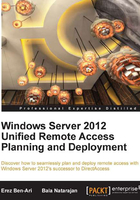
上QQ阅读APP看书,第一时间看更新
Chapter 1. Understanding IPv6 and IPv4-IPv6 Interoperability
At the beginning of this book, we promised that you wouldn't have to learn IPv6 to partake in the wonderful Unified Remote Access technology, and that was true. Nevertheless, understanding IPv6 and the transition technologies is not only a chance to prepare for the inevitable day when IPv6 becomes the common standard, it may also come in handy if you have to troubleshoot advanced problems with Unified Remote Access. In addition, if you are required to plan complex environments that integrate Unified Remote Access and other networking solutions, you might find the following information more than useful.
The topics we will cover in this chapter are as follows:
- My network's fine, so if it ain't broken, why fix it?
- The IPv6 addressing schemes
- IPv6 address assignment
- IPv6 and name resolution
- A little more about DNS
- Multiple stacks
- Operating system compatibility
- Protocol transition technologies
- ISATAP
- DNS64 and NAT64
- 6to4
- Teredo
- IP-HTTPS
- Practical considerations for IPv6 and IPv4
- Unified Remote Access and Group Policy
- Public Key Infrastructure (PKI)